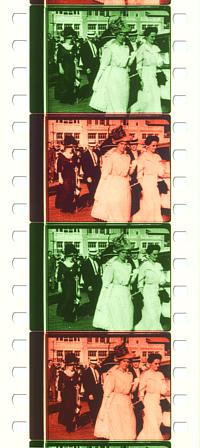The 1983 documentary, The Indomitable Teddy Roosevelt, is remarkable in the amount of early motion picture film unearthed by producer - director Harrison Engle. In that footage are a few short, precious scenes of surviving Kinemacolor, shot somewhere around 1908-1909. Nowadays the conversion of this old film would probably be done entirely by electronic means, but in 1983 the method used was strangely reminiscent of Biocolor, the Kinemacolor wannabe that never gained wide acceptance due to a number of court cases.
 Kinemacolor negative, with alternate frames photographed through red and green filters. |  Kinemacolor print requiring rotating color wheel to add color to the alternating frames. |
 Fringing of the Kinemacolor picture is obvious in this composite of two adjacent frames. In actual practice, the fringing is not as noticeable because the red and green fringes never appear on the screen at the same time, though the color in the image exhibits a distinct flicker. |
 The producers optically printed the black & white negative to Eastmancolor stock using alternating red and green filters. The result was essentially the Biocolor scheme. The screened image was very faithful to the appearance of the original Kinemacolor. |  Alas, this is what the strip of film actually looks like today, with the green dye faded into oblivion. Faulty as it may have been, the Kinemacolor system retained all the original color information for nearly 80 years, and will continue to do so, while the modern color print failed to do so for even fifteen years. Good thing that color film stocks weren't invented sooner. | |
 Our thanks to Harrison Engle and Signal Hill Entertainment for providing this motion picture film. The Indomitable Teddy Roosevelt is available on DVD from Image Entertainment. In the words of its subject, "It's Bully, just Bully!", whatever that means. In the words of your Curator, it's an engrossing film, an eye opening history lesson, and a feast for fans of early cinematography. George C. Scott's distinctive voice is ideal for the narration and John Phillip Sousa's music, played in the context of the screen image, is more than military pomp and circumstance, it rounds out the time-capsule atmosphere.
Our thanks to Harrison Engle and Signal Hill Entertainment for providing this motion picture film. The Indomitable Teddy Roosevelt is available on DVD from Image Entertainment. In the words of its subject, "It's Bully, just Bully!", whatever that means. In the words of your Curator, it's an engrossing film, an eye opening history lesson, and a feast for fans of early cinematography. George C. Scott's distinctive voice is ideal for the narration and John Phillip Sousa's music, played in the context of the screen image, is more than military pomp and circumstance, it rounds out the time-capsule atmosphere.
MBH